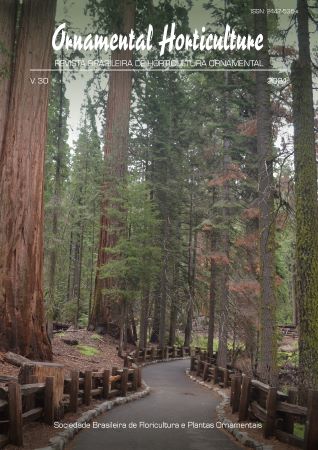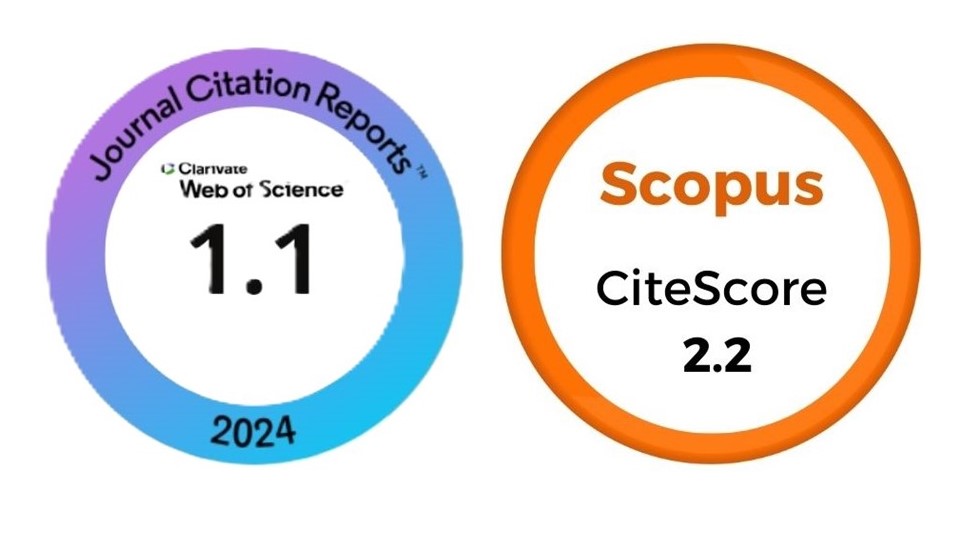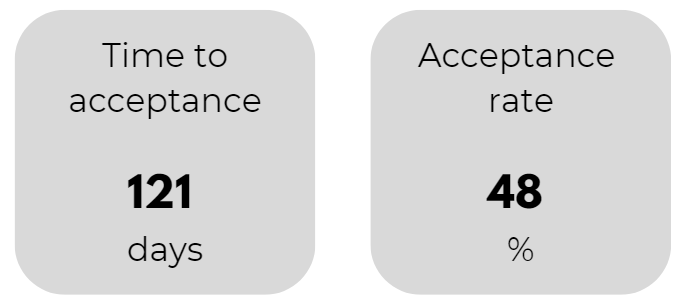Substrato à base de resíduos agroindustriais e coloração de bancadas de cultivo influenciam a produção de Zinnia elegans
DOI:
https://doi.org/10.1590/2447-536X.v30.e242726Palavras-chave:
agricultura regenerativa, cultivo protegido, plantas ornamentais, sustentabilidadeResumo
Dentre as diversas tecnologias que podem ser utilizadas para modificar as condições ambientais no cultivo protegido, o aproveitamento de resíduos agrícolas e a utilização de bancadas de cultivo de diversas cores podem ser benéficos às plantas, proporcionando um desenvolvimento adequado e conferindo maior sustentabilidade ao sistema de produção. O estudo teve como objetivo identificar o potencial de utilização de substrato à base de resíduos agroindustriais e bancadas coloridas como alternativas para a produção de Zinnia elegans. O experimento foi conduzido na Universidade Estadual de Mato Grosso do Sul (UEMS), Cassilândia-MS, utilizando delineamento inteiramente casualizado, disposto em esquema fatorial 3 x 5 (três cores de bancada x cinco doses de substrato), com três repetições. Os tratamentos consistiram de três bancadas coloridas (branca, vermelha e controle) e cinco misturas de substratos com diferentes concentrações de resíduo agroindustrial (SBRA) e Ecosolo® (0, 25%, 50%, 75% e 100%) em qual Zinnia elegans foi cultivada. As variáveis analisadas foram altura das plantas, comprimento dos entrenós, número de folhas, teor relativo de clorofila (SPAD), diâmetro do caule, diâmetro da flor, número de pétalas, tempo necessário para floração e massa seca da parte aérea. Verificou-se que a composição do substrato afetou a maioria das características avaliadas, exceto comprimento dos entrenós e diâmetro do caule. As bancadas resultaram em diferenças significativas no teor relativo de clorofila e no número de pétalas. A adição de proporções crescentes de SBRA proporciona maior crescimento vegetativo e desenvolvimento floral nas plantas de Zinnia elegans.
Downloads
Referências
AGARWAL, P.; SAHA, S.; HARIPRASAD, P. Agro-industrial-residues as potting media: Physicochemical and biological characters and their influence on plant growth. Biomass Conversion and Biorefinery, p.1-24, 2021. https://doi.org/10.1007/s13399-021-01998-6
CABRAL, R.C.; VENDRUSCOLO, E.P.; MARTINS, M.B.; ZOZ, T.; COSTA, E.; SILVA, A.G. Material reflectante en bancos de cultivo y paja de arroz sobre el sustrato en la producción de plántulas de papaya. Revista Mexicana de Ciências Agrícolas, v.11, n.8, p.1713-1723, 2020. https://doi.org/10.29312/remexca.v11i8.2481
CAMPOS, R.S.; COSTA, E.; CAVALCANTE, D.F.; FREITAS, R.A.; BINOTTI, F.F.S. Tomateiro cereja ornamental em diferentes ambientes protegidos e materiais refletores em bancada de cultivo. Revista Caatinga, v.36, n.1, p.9-20, 2023. http://dx.doi.org/10.1590/1983-21252023v36n102rc
COSTA, E.; LOPES, T.C.; SILVA, A.G.; ZOZ, T.; SALLES, J.S.; LIMA, A.H.F.; BINOTTI, F.F.S.; VIEIRA, G.H.C. Reflective material in the formation of Dipteryx alata seedlings. Research, Society and Development, v.9, n.8, p.1-17, 2020b. https://doi.org/10.33448/rsd-v9i8.5428
COSTA, E.; MARTINS, M.B.; VENDRUSCOLO, E.P.; DA SILVA, A.G.; ZOZ, T.; BINOTTI, F.F.S.; WITT, T.W.; SERON, C.C. Greenhouses within the Agricultura 4.0 interface. Revista Ciência Agronômica, v.51, p.1-12, 2020a. https://doi.org/10.5935/1806-6690.20200089
COSTA, G.G.S.; COSTA E.; SILVA, E.M.; BORGES, R.S.; BINOTTI, F.F.S.; VIEIRA, G.H.C.; SOUZA, A.F.G.O. Shading level, reflective material, and seeding depth on the growth of baru seedlings. Agricultural Engineering International: CIGR Journal, v.22, n.4, p.83-92, 2020c.
COSTA, J.C.F.; MENDONÇA, R.M.N.; FERNANDES, L.F.; OLIVEIRA, F.P.; SANTOS, D. Caracterização física de substratos orgânicos para o enraizamento de estacas de goiabeira. Revista Brasileira de Agropecuária Sustentável, v.7, n.2, p. 90-96, 2017. http://dx.doi.org/10.21206/rbas.v7i2.390
DAMACENO, F.M.; PEREIRA, N.; ANDRADE, E.A.; CARVALHO-ZANAO, M.P.; JUNIOR, L.A.Z. Coconut fiber and carbonized rice husks mixtures may reduce the use of commercial pine bark substrate in Catharanthus roseus and Zinnia elegans cultivation. Environmental Engineering and Management Journal, v.21, n.4, p.651-660, 2022.
FRIZZONE, J.A.; FREITAS, P.S.L.D.; REZENDE, R.; FARIA, M.A.D. Microirrigação: gotejamento e microaspersão. Maringá: Eduem, 2012.
MARTINS, R.D.C.F.; PÊGO, R.G.; CRUZ, E.S.D.; ABREU, J.F.G.; CARVALHO, D.F.D. Production and quality of zinnia under different growing seasons and irrigation levels. Ciência e Agrotecnologia, v.45, p.e033720, 2021. https://doi.org/10.1590/1413-7054202145033720
MENEGAES, J.F.; NUNES, U.R.; BELLE, R.A.; LUDWIG, E.J.; SANGOI, P.R.; SPEROTTO, L. Germinação de sementes de Carthamus tinctorius em diferentes substratos. Acta Iguazu, v.6, n.3, p.22-30, 2017. https://doi.org/10.48075/actaiguaz.v6i3.17705
MORTATE, R.K.; COSTA, E.; VIEIRA, G.H.C.; SOUSA, H.F.; BORGES, R.S.; BARBOSA, W.F.S.; COSTA, G.G.S. Levels of shading and reflective material in benches for Schizolobium amazonicum seedlings. Journal of Agricultural Science, v.11, n.5, p.485-495, 2019. https://doi. org/10.5539/jas.v11n5p485
NANYA, K.; ISHIGAMI, Y.; HIKOSAKA, S.; GOTO, E. Effects of blue and red light on stem elongation and flowering of tomato seedlings. Acta Horticulturae, v.956, p.261-266, 2012. https://doi.org/10.17660/actahortic.2012.956.29
ORTEGA, F.; VERSINO, F.; LÓPEZ, O. V.; GARCÍA, M. A. Biobased composites from agro-industrial wastes and by-products. Emergent Materials, v.5, n.3, p.873-921, 2022. https://doi.org/10.1007/s42247-021-00319-x
OVADIA, R.; DORI, I.; NISSIM-LEVI, A.; SHAHAK, Y.; OREN-SHAMIR, M. Coloured shade-nets influence stem length, time to flower, flower number and inflorescence diameter in four ornamental cut-flower crops. The Journal of Horticultural Science and Biotechnology, v.84, n.2, p.161-166, 2009. https://doi.org/10.1080/14620316.2009.11512498
PÊGO, R.G.; ANTUNES, L.F.D.S.; SILVA, A.R.C.Vigor of zinnia seedlings produced in alternative substrate in trays with different cell size a. Ornamental Horticulture, v.25, n.4, p.417-424, 2019. https://doi.org/10.1590/2447-536X.v25i4.2049
POUDEL, P.R.; KATAOKA, I.; MOCHIOKA, R. Effect of red-and blue-light-emitting diodes on growth and morphogenesis of grapes. Plant cell, tissue and organ culture, v.92, n.2, p.147-153, 2008. https://doi.org/10.1007/s11240-007-9317-1
RADZIEMSKA, M.; VAVERKOVÁ, M.D.; ADAMCOVÁ, D.; BRTNICKÝ, M.; MAZUR, Z. Valorization of fish waste compost as a fertilizer for agricultural use. Waste and Biomass Valorization, v.10, n.9, p.2537-2545, 2019. https://doi.org/10.1007/s12649-018-0288-8
RIBEIRO, J.V.S.; SEMENSATO, L.R.; VENDRUSCOLO, E.P. Increasing doses of cattle manure for organic chili pepper production. Revista de Agricultura Neotropical, v.7, n.3, p.109-112, 2020. https://doi.org/10.32404/rean.v7i3.5158
SAINI, I.; YADAV, V.K.; AGGARWAL, A.; KAUSHIK, P. Effect of superphosphate, urea and bioinoculants on Zinnia elegans Jacq. Indian Journal of Experimental Biology (IJEB), v.58, n.10, p.730-737, 2020.
SALLES, J.S.; LIMA, A.H.F.; COSTA, E. Mudas de jambolão sob níveis de sombreamento, bancadas refletoras e profundidade de semeadura. Revista de Agricultura Neotropical, v.4, n.5, p.110-118, 2017. https://doi.org/10.32404/rean.v4i5.2181
SINGH, R.; DAS, R.; SANGWAN, S.; ROHATGI, B.; KHANAM, R.; PEERA, S. P. G.; DAS, S.; LYNGDOH, Y. A.; LANGYAN, S.; SHUKLA, A.; MANOJ, S.; MISRA, S. Utilisation of agro-industrial waste for sustainable green production: a review. Environmental Sustainability, v.4, n.4, p.619-636, 2021. https://doi.org/10.1007/s42398-021-00200-x
SOUZA, A.M.B.D.; VIEIRA, G.R.; SGOBBE, G.; FERREIRA, K.B.; CAMPOS, T.S.; PIVETTA, K.F.L. Initial growth of zinnia seedlings in substrate with different proportions of biosolid. Ornamental Horticulture, v.28, p.220-229, 2022. https://doi.org/10.1590/2447-536X. v28i2.2482
TAIZ, L.; ZEIGER, E.; MOLLER, I.M.; MURPHY, A. Plant physiology and development. Sunderland: Sinauer Associates, 2015.
VENDRUSCOLO, E.P.; DE CASTRO SERON, C.; CAVALCANTE, D.F.; DE ALMEIDA BATISTA, G.; SELEGUINI, A. Produção de mini plantas de Zinnia elegans em substrato à base de resíduo agroindustrial. Research, Society and Development, v.9, n.8, p.e272985332, 2020. https://doi.org/10.33448/rsd-v9i8.5332
VIEIRA, L.N.; DE FRAGA, H.P.F.; ANJOS, K.G.; PUTTKAMMER, C.C.; SCHERER, R.F.; DA SILVA, D.A.; GUERRA, M.P. Light-emitting diodes (LED) increase the stomata formation and chlorophyll content in Musa acuminata (AAA) ‘Nanicão Corupá’ in vitro plantlets. Theoretical and Experimental Plant Physiology, v.27, n.2, p.91-98, 2015. https://doi.org/10.1007/s40626-015-0035-5
YAASHIKAA, P.R.; KUMAR, P.S.; VARJANI, S. Valorization of agro-industrial wastes for biorefinery process and circular bioeconomy: A critical review. Bioresource Technology, v. 343, p. 126126, 2022. DOI: https://doi.org/10.1016/j.biortech.2021.126126
ZHENG, L.; VAN LABEKE, M.C. Long-term effects of red-and blue-light emitting diodes on leaf anatomy and photosynthetic efficiency of three ornamental pot plants. Frontiers in Plant Science, v.8, p.917, 2017. https://doi.org/10.3389/fpls.2017.00917
Downloads
Publicado
Edição
Seção
Licença
Copyright (c) 2024 Ornamental Horticulture

Este trabalho está licenciado sob uma licença Creative Commons Attribution 4.0 International License.








